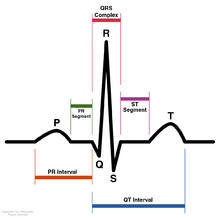Ajmaline
 | |
| Clinical data | |
|---|---|
| AHFS/Drugs.com | International Drug Names |
| ATC code | C01BA05 (WHO) |
| Identifiers | |
| |
| CAS Number |
4360-12-7 |
| PubChem (CID) | 20367 |
| DrugBank |
DB01426 |
| ChemSpider |
10469368 |
| UNII |
1PON08459R |
| KEGG |
D00199 |
| ChEMBL |
CHEMBL1230919 |
| Chemical and physical data | |
| Formula | C20H26N2O2 |
| Molar mass | 326.433 g/mol |
| 3D model (Jmol) | Interactive image |
| |
| |
| | |
Ajmaline (also known by trade names Gilurytmal, Ritmos, and Aritmina) is an alkaloid that is class Ia antiarrhythmic agent. It is often used to bring out typical findings of ST elevations in patients suspected of having Brugada syndrome.
The compound was first isolated by Salimuzzaman Siddiqui in 1931 [1] from the roots of Rauwolfia serpentina. He named it ajmaline, after Hakim Ajmal Khan, one of the most illustrious practitioners of Unani medicine in South Asia.[2] Ajmaline can be found in most species of the Rauwolfia genus as well as Catharanthus roseus.[3] In addition to Southeast Asia, Rauwolfia species have also been found in tropical regions of India, Africa, South America, and some oceanic islands. Other indole alkaloids found in Rauwolfia include reserpine, ajmalicine, serpentine, corynanthine, and yohimbine. While 86 alkaloids have been discovered throughout Rauvolfia vomitoria, ajmaline is mainly isolated from the stem bark and roots of the plant.[3]
Due to the low bioavailability of ajmaline, a semisynthetic propyl derivative called prajmaline (trade name Neo-gilurythmal) was developed that induces similar effects to its predecessor but has better bioavailability and absorption.[4]
Mechanism of action

Ajmaline was first discovered to lengthen the refractory period of the heart by blocking sodium ion channels,[3] but it has also been noted that it is also able to interfere with the hERG (human Ether-a-go-go-Related Gene) potassium ion channel.[5] In both cases, Ajmaline causes the action potential to become longer and ultimately leads to bradycardia. When ajmaline reversibly blocks hERG, repolarization occurs more slowly because it is harder for potassium to get out due to less unblocked channels, therefore making the RS interval longer. Ajmaline also prolongs the QR interval since it can also act as sodium channel blocker, therefore making it take longer for the membrane to depolarize in the first case. In both cases, ajmaline causes the action potential to become longer. Slower depolarization or repolarization results in a lengthened QT interval (the refractory period), and therefore makes it take more time for the membrane potential to get below the threshold level so the action potential can be re-fired. Even if another stimulus is present, action potential cannot occur again until after complete repolarization. Ajmaline causes action potentials to be prolonged, therefore slowing down firing of the conducting myocytes which ultimately slows the beating of the heart.
Diagnosis of Brugada syndrome

Brugada syndrome is a genetic disease that result in mutations in the sodium ion channel (gene SCN5A) of the myocytes in the heart.[6] Brugada syndrome can result in ventricular fibrillation and potentially death. It is a major cause of sudden unexpected cardiac death in young, otherwise healthy people. While the characteristic patterns of Brugada syndrome on an electrocardiogram may be seen regularly, often the abnormal pattern is only seen spontaneously due to unknown triggers or after challenged by particular drugs. Ajmaline is used intravenously to test for Brugada syndrome since they both affect the sodium ion channel.[7] In an afflicted person who was induced with ajmaline, the electrocardiogram would show the characteristic pattern of the syndrome where the ST segment is abnormally elevated above the baseline. Due to complications that could arise with the ajmaline challenge, a specialized nurse should perform the administration and have an emergency defibrillator nearby.
Therapeutic use
Ajmaline has been used as a treatment for Wolff-Parkinson-White syndrome which is characterized by arrhythmias with the ventricles contracting prematurely resulting in tachycardia and a shortened refractory period.[8] In patients with WPW, ajmaline lengthened the refractory period and has been seen to prevent the initiation of tachycardia. Ajmaline was seen to be more effective than lidocaine (an accepted drug for treatment) in terminating ventricular tachycardia for acute treatment or emergency therapy for people with recurring symptoms. Ajmaline stopped the tachycardia in 10 of 15 patients while lidocaine only stopped VT in 2 of 16 patients.[9]
See also
References
- ↑ Siddiqui, S.; Siddiqui, R. H. (1931). J. Indian Chem. Soc. 8: 667–80.
- ↑ Ahmed Nasim Sandilvi (2003), Salimuzzaman Siddiqui: pioneer of scientific research in Pakistan. Daily Dawn. 12 April 2003. Retrieved on 19 July 2007.
- 1 2 3 Roberts, M.F.; Wink, M. (1998), Alkaloids: Biochemistry, Ecology, and Medical applications. Plenum Press.
- ↑ Hinse, C.; Stöckigt, J. (2000). "The structure of the ring-opened N beta-propyl-ajmaline (Neo-Gilurytmal) at physiological pH is obviously responsible for its better absorption and bioavailability when compared with ajmaline (Gilurytmal).". Pharmazie. 55 (7): 531–2. PMID 10944783.
- ↑ Kiesecker, C.; Zitron E.; Lück S.; Bloehs R.; Scholz E.P.; Kathöfer S.; Thomas D.; Kreye V.A.; Katus H.A.; Schoels W.; Karle C.A.; Kiehn J. (2004). "Class Ia anti-arrhythmic drug ajmaline blocks HERG potassium channels: mode of action.". Naunyn Schmiedebergs Arch Pharmacol. 370 (6): 423–35. doi:10.1007/s00210-004-0976-8. PMID 15599706.
- ↑ Hedley, P. L., Jørgensen, P., Schlamowitz, S., Moolman-Smook, J., Kanters, J. K., Corfield, V. A.; Christiansen, M. (2009). "The genetic basis of Brugada syndrome: A mutation update.". Hum. Mut. 30 (9): 1256–1266. doi:10.1002/humu.21066. PMID 19606473.
- ↑ Rolf, S.; Bruns, H.J.; Wichter, T.; Kirchhof, P.; Ribbing, M.; Wasmer, K.; Paul, M.; Breithardt, G.; Haverkamp, W.; Eckardt, L. (2003). "The ajmaline challenge in Brugada syndrome: Diagnostic impact, safety, and recommended protocol.". EUR HEART J. 24 (12): 1104–1112. doi:10.1016/s0195-668x(03)00195-7. PMID 12804924.
- ↑ Wellens H.J.; Bär F.W.; , Gorgels A.P.; Vanagt E.J. (1980). "Use of ajmaline in patients with the Wolff-Parkinson-White syndrome to disclose short refractory period of the accessory pathway.". Am J Cardiol. 45 (1): 130–3. doi:10.1016/0002-9149(80)90230-1. PMID 7350760.
- ↑ Manz M.; Lüderitz B. (1988). "Emergency therapy of ventricular tachycardias: lidocaine versus ajmaline.". Dtsch Med Wochenschr. 113 (34): 1317–21. doi:10.1055/s-2008-1067813. PMID 3044723.